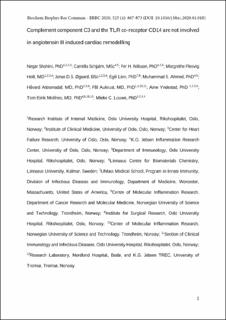Complement component C3 and the TLR co-receptor CD14 are not involved in angiotensin II induced cardiac remodelling
| dc.contributor.author | Shahini, Negar | |
| dc.contributor.author | Schjalm, Camilla | |
| dc.contributor.author | Nilsson, Per | |
| dc.contributor.author | Holt, Margrethe Flesvig | |
| dc.contributor.author | Øgaard, Jonas | |
| dc.contributor.author | Lien, Egil | |
| dc.contributor.author | Ahmed, Muhammad Shakil | |
| dc.contributor.author | Attramadal, Håvard | |
| dc.contributor.author | Aukrust, Pål | |
| dc.contributor.author | Yndestad, Arne | |
| dc.contributor.author | Mollnes, Tom Eirik | |
| dc.contributor.author | Louwe, Mieke C. | |
| dc.date.accessioned | 2021-03-08T13:33:39Z | |
| dc.date.available | 2021-03-08T13:33:39Z | |
| dc.date.created | 2020-08-05T08:36:08Z | |
| dc.date.issued | 2020 | |
| dc.identifier.citation | Biochemical and Biophysical Research Communications - BBRC. 2020, 523 (4), 867-873. | en_US |
| dc.identifier.issn | 0006-291X | |
| dc.identifier.uri | https://hdl.handle.net/11250/2732209 | |
| dc.description.abstract | Inflammation is centrally involved in the development of cardiac hypertrophy and the processes of remodelling. The complement system and Toll-like receptor (TLR) family, two upstream arms of the innate immune system, have previously been reported to be involved in cardiac remodelling. However, the role of complement component 3 (C3), TLR co-receptor CD14 and the synergy between them have not been addressed during pressure overload-induced cardiac remodelling. Here, we examined angiotensin II-induced cardiac hypertrophy and remodelling for 7 days in male C57Bl/6 J mice deficient in C3, CD14, or both (C3CD14), and WT controls. Angiotensin II infusion induced a mild concentric hypertrophic phenotype in WT mice with increased left ventricle weight, wall thicknesses and reduced ventricular internal diameter, associated with increased cardiac fibrosis. However, there were no differences between WT mice and mice deficient for C3, CD14 or C3CD14, as systolic blood pressure, cardiac function and structure and levels of fibrosis were comparable between WT mice and the three other genotypes. C5a did not change in angiotensin II treated mice, whereas Mac2 levels were increased in angiotensin II treated mice, but did not differ between genotypes. The inflammatory IL-6 response was comparable between WT and C3 deficient mice, however, it was decreased in CD14 and C3CD14 deficient mice. We conclude that deficiency in C3, CD14 or C3CD14 had no effect on cardiac remodelling following angiotensin II-induced pressure overload. This suggests that C3 and CD14 are not involved in angiotensin II-induced adverse cardiac remodelling. | en_US |
| dc.language.iso | eng | en_US |
| dc.publisher | Elsevier | en_US |
| dc.rights | Attribution-NonCommercial-NoDerivatives 4.0 Internasjonal | * |
| dc.rights.uri | http://creativecommons.org/licenses/by-nc-nd/4.0/deed.no | * |
| dc.title | Complement component C3 and the TLR co-receptor CD14 are not involved in angiotensin II induced cardiac remodelling | en_US |
| dc.type | Peer reviewed | en_US |
| dc.type | Journal article | en_US |
| dc.description.version | acceptedVersion | en_US |
| dc.source.pagenumber | 867-873 | en_US |
| dc.source.volume | 523 | en_US |
| dc.source.journal | Biochemical and Biophysical Research Communications - BBRC | en_US |
| dc.source.issue | 4 | en_US |
| dc.identifier.doi | 10.1016/j.bbrc.2020.01.018 | |
| dc.identifier.cristin | 1821678 | |
| dc.relation.project | Norges forskningsråd: 223255 | en_US |
| cristin.ispublished | true | |
| cristin.fulltext | postprint | |
| cristin.qualitycode | 1 |

